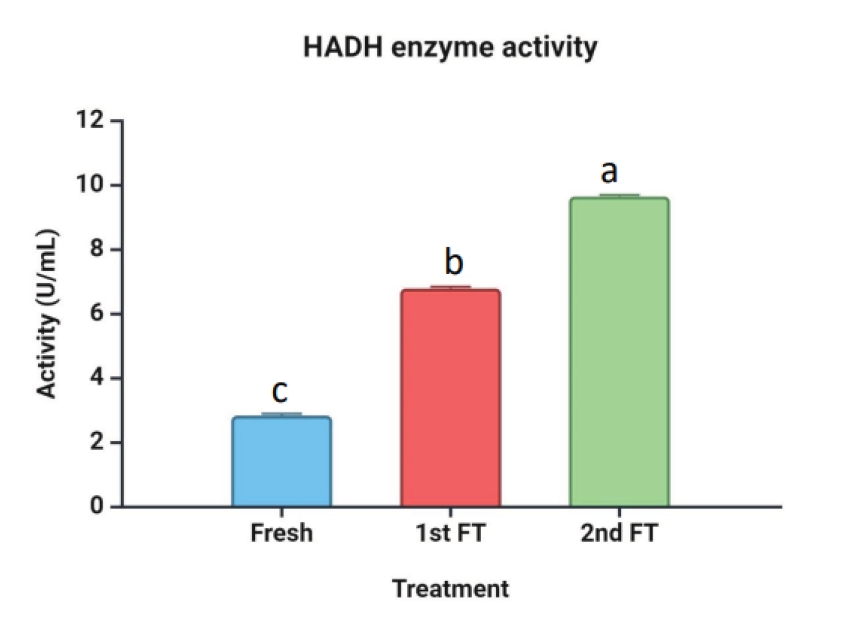DISTINCTION OF FRESH FROM FROZEN-THAWED BUFFALO MEAT USING Β-HYDROXYLACYL-COA-DEHYDROGENASES (HADH) ASSAY
DOI:
https://doi.org/10.56825/bufbu.2025.4424224Keywords:
Bubalus bubalis, buffaloes , buffalo meat , frozen-thawed buffalo meat , enzyme-basedAbstract
The present study aimed to differentiate the fresh from frozen-thawed buffalo meat in the supply chain using a simple enzyme-based method. In the buffalo meat supply chain, due to faulty cold chain maintenance and irregular power supply, the meat gets repeatedly thawed which ultimately leads to quality deterioration. The buffalo meat samples were divided into three groups namely fresh (no freezing and thawing), 1st FT (meat was frozen at -18±2oC for 48 h followed by thawing at 4±1oC for 12 h), and 2nd FT (1st FT meat was again frozen at -18±2oC for 48 h followed by thawing at 4±1oC for 12 h). The meat press juice was collected from meat samples for HADH enzyme activity estimation. The meat quality parameters (pH, antioxidant activity, water holding capacity, cooking loss, thawing loss, extract release volume, microbiological count, and color) were also determined for correlation with HADH enzyme activity using Pearson’s two-tailed correlation. The enzyme assay showed that HADH concentration significantly (P<0.05) increased from 2.82±0.06 U/mL (fresh) to 6.77±0.05 U/mL and 9.63±0.06 U/mL for 1st FT and 2nd FT, respectively signifying its dependency on freeze-thaw cycles. The findings of meat quality parameters obtained for buffalo meat at different freeze-thaw cycles correlate significantly (r>0.90) with the HADH activity thereby indicating the deterioration of meat quality with an increase in the number of freeze-thaw cycles. Therefore, the HADH enzyme assay in meat press juice and meat quality parameters could be used to differentiate fresh from frozen-thawed buffalo meat.
Downloads
Metrics
References
APHA. 2001. Compendium of Methods for the Microbiological Examination of Foods, 4th ed. American Public Health Association, Washington D.C., USA.
Bae, Y.S., J.C. Lee, S. Jung, H.J. Kim, S.Y. Jeon, D.H. Park, S.K. Lee and C. Jo. 2014. Differentiation of deboned fresh chicken thigh meat from the frozen-thawed one processed with different deboning conditions. Korean J. Food Sci. An., 34(1): 73. DOI: 10.5851/kosfa.2014.34.1.73
Ballin, N.Z. and R. Lametsch. 2008. Analytical methods for authentication of fresh vs. thawed meat - A review. Meat Sci., 80(2): 151-159. DOI: 10.1016/j.meatsci.2007.12.024
Boerrigter-Eenling, R., M. Alewijn, Y. Weesepoel and S. Van Ruth. 2017. New approaches towards discrimination of fresh/chilled and frozen/thawed chicken breasts by HADH activity determination: Customized slope fitting and chemometrics. Meat Sci., 126: 43-49. DOI: 10.1016/j.meatsci.2016.12.009
Chen, M.T., W.D. Yang and S.L. Guo. 1988. Differentiation between fresh beef and thawed frozen beef. Meat Sci., 24(3): 223-226. DOI: 10.1016/0309-1740(88)90080-0
Cheng, S., X. Wang, R. Li, H. Yang, H. Wang, H. Wang and M. Tan. 2019. Influence of multiple freeze-thaw cycles on quality characteristics of beef semimembranous muscle: With emphasis on water status and distribution by LF-NMR and MRI. Meat Sci., 147: 44-52. DOI: 10.1016/j.meatsci.2018.08.020
Cheung, T.C., E.C.C. Cheng, H.Y. Chan, S.K. Tong, P.K. Chan, F.W. Lee, Y.C. Wong and D.W.M. Sin. 2015. Development of a validated database for the authentication of fresh/chilled and frozen pork using β-Hydroxylacyl-CoA-dehydrogenases (HADH) assay. Int. J. Food Prop., 18(1): 73-80. DOI: 10.1080/10942912.2013.815201
Du, X., P. Chang, J. Tian, B. Kong, F. Sun and X. Xia. 2020. Effect of ice structuring protein on the quality, thermal stability and oxidation of mirror carp (Cyprinus carpio L.) induced by freeze-thaw cycles. LWT, 124: 109140. DOI: 10.1016/j.lwt.2020.109140
Duflos, G., B. Le Fur, V. Mulak, P. Becel and P. Malle. 2002. Comparison ofmethods of differentiating between fresh and frozen - Thawed fish or fillets. J. Sci. Food Agr., 82(12): 1341-1345. DOI: 10.1002/jsfa.1195
Fernández, M., S. Mano, G.D.G. De Fernando, J.A. Ordóñez and L. Hoz. 1999. Use of β-hydroxyacyl-CoA-dehydrogenase (HADH) activity to differentiate frozen and unfrozen fish and shellfish. Eur. Food Res. Technol., 209: 205-208.
FSSAI. 2016. Food Safety and Standards (Food Products Standards and Food Additives) Tenth Amendment Regulations. Food Safety and Standards Authority of India Ministry of Health and Family Welfare, Government of India, New Delhi, India.
Hamm, R. 1979. Delocalization of mitochondrial enzymes during freezing and thawing of skeletal muscle. In Fennema, O.R. (ed.) Proteins at Low Temperatures. Advances in Chemistry Series. American Chemical Society, Washington DC, USA.
Huff-Lonergan, E. and S.M. Lonergan. 2005. Mechanisms of water-holding capacity of meat: The role of postmortem biochemical and structural changes. Meat Sci., 71(1): 194-204. DOI: 10.1016/j.meatsci.2005.04.022
Jaiswal, R.K., S.K. Mendiratta, S. Talukder, A. Soni, S. Chand and B.L. Saini. 2020. Application of lipase based enzymatic Time Temperature Indicator (TTI) as quality marker for frozen chicken meat. Food Sci. Technol. Res., 26(1): 9-16. DOI: 10.3136/fstr.26.9
Jay, J.M. 1964. Beef microbial quality determined by Extract release volume (ERV). Food Technol.-Chicago, 18: 1637-1641.
Jeong, J.Y., G.D. Kim, H.S. Yang and S.T. Joo. 2011. Effect of freeze-thaw cycles on physicochemical properties and color stability of beef semimembranosus muscle. Food Res. Int., 44(10): 3222-3228. DOI: 10.1016/j.foodres.2011.08.023
Karakosta, L.K., K.A. Vatavali, I.S. Kosma, A.V. Badeka and M.G. Kontominas. 2022. Combined effect of chitosan coating and Laurel essential oil (Laurus nobilis) on the microbiological, chemical, and sensory attributes of Water buffalo meat. Foods, 11(11): 1664. DOI: 10.3390/foods11111664
Leygonie, C., T.J. Britz and L.C. Hoffman. 2012. Impact of freezing and thawing on the quality of meat: Review. Meat Sci., 91(2): 93-98. DOI: 10.1016/j.meatsci.2012.01.013
Li, F., B. Wang, B. Kong, S. Shi and X. Xia. 2019. Decreased gelling properties of protein in mirror carp (Cyprinus carpio) are due to protein aggregation and structure deterioration when subjected to freeze-thaw cycles. Food Hydrocolloids, 97: 105223. DOI: 10.1016/j.foodhyd.2019.105223
Mishra, V., A. Tarafdar, S. Talukder, S.K. Mendiratta, R.K. Agrawal, R.K. Jaiswal and G.P. Bomminayuni. 2023. Enhancing the shelf life of chevon Seekh Kabab using chitosan edible film and Cinnamomum zeylanicum essential oil. J. Food Sci. Technol., 60(6): 1814-1825.
Nicolalde, C., A.J. Stetzer, E. Tucker, F.K. McKeith and M.S. Brewer. 2006. Effect of freezing, exposure to enhancement solution and modified atmosphere on pork bone discoloration. J. Muscle Foods, 17(4): 428-442. DOI: 10.1111/j.1745-4573.2006.00061.x
Ottavian, M., L. Fasolato, L. Serva, P. Facco and M. Barolo. 2014. Data fusion for food authentication: fresh/frozen-thawed discrimination in West African Goatfish (Pseudupeneus prayensis) fillets. Food Bioprocess Tech., 7: 1025-1036. DOI: 10.1007/s11947-013-1157-x
Pan, N., C. Dong, X. Du, B. Kong, J. Sun and X. Xia. 2021. Effect of freeze-thaw cycles on the quality of quick-frozen pork patty with different fat content by consumer assessment and instrument-based detection. Meat Sci., 172: 108313. DOI: 10.1016/j.meatsci.2020.108313
Qi, J., C. Li, Y. Chen, F. Gao, X. Xu and G. Zhou. 2012. Changes in meat quality of ovine longissimus dorsi muscle in response to repeated freeze and thaw. Meat Sci., 92(4): 619-626. DOI: 10.1016/j.meatsci.2012.06.009
Rahman, M.H., M.M. Hossain, S.M.E. Rahman, M.A. Hashem and D.H. Oh. 2014. Effect of repeated freeze-thaw cycles on beef quality and safety. Food Science of Animal Resources, 34(4): 482-495. DOI: 10.5851/kosfa.2014.34.4.482
Ramos, E.M., L.A.M. Gomide, A.L.S. Ramos and L.A. Peternelli. 2004. Effect of stunning methods on the differentiation of frozen-thawed bullfrog meat based on the assay of ß-hydroxyacyl-CoA-dehydrogenase. Food Chem., 87(4): 607-611. DOI: 10.1016/j.foodchem.2004.01.013
Sen, A.R. and N. Sharma. 2005. An enzymic method for differentiating frozen and thawed fresh goat meat. J. Food Sci. Tech. Mys., 42(5): 392-395.
Srinivasan, S., Y. L. Xiong and S.P. Blanchard. 1997. Effects of freezing and thawing
methods and storage time on thermal properties of freshwater prawns (Macrobrachium rosenbergii). J. Sci. Food Agr., 75: 37-44. DOI: 10.1002/(SICI)1097-0010(199709)75:1<37::AID-JSFA838>3.0.CO;2-L
Strange, E.D., R.C. Benedict, J.L. Smith and C.E. Swift. 1977. Evaluation of rapid tests for monitoring alterations in meat quality during storage. J. Food Protecht., 40(12): 843-847. DOI: 10.4315/0362-028X-40.12.843
Tarladgis, B.G., B.M. Watts, M.T. Younathan and L. Dugan Jr. 1960. A distillation method for the quantitative determination of malonaldehyde in rancid foods. J. Am. Oil Chem. Soc., 37(1): 44-48. DOI: 10.1007/BF02630824
Toldra, F., Y. Torrero and J. Flores. 1991. Simple test for differentiation between fresh pork and frozen/thawed pork. Meat Sci., 29(2): 177-181. DOI: 10.1016/0309-1740(91)90064-W
Trout, E.S., M.C. Hunt, D.E. Johnson, J.R. Claus, C.L. Kasmer, D.H. Kropf and S. Stroda. 1992. Chemical, physical, and sensory characterization of ground beef containing 5 to 30 percent fat. J. Food Sci., 57(1): 25-29. DOI: 10.1111/j.1365-2621.1992.tb05416.x
Vatavali, K., L. Karakosta, C. Nathanailides, D. Georgantelis and M.G. Kontominas. 2013. Combined effect of chitosan and oregano essential oil dip on the microbiological, chemical, and sensory attributes of red porgy (Pagrus pagrus) stored in ice. Food Bioprocess. Tech., 6(12): 3510-3521. DOI: 10.1007/s11947-012-1034-z
Visciano, P. and M. Schirone. 2021. Food frauds: Global incidents and misleading situations. Trends Food Sci. Tech., 114: 424-442. DOI: 10.1016/j.tifs.2021.06.010
Wei, R., P. Wang, M. Han, T. Chen, X. Xu and G. Zhou. 2017. Effect of freezing on electrical properties and quality of thawed chicken breast meat. Asian-Austral. J. Anim., 30(4): 569. DOI: 10.5713/ajas.16.0435
Xia, X., B. Kong, Q. Liu and J. Liu. 2009. Physiochemical changes and protein oxidation in porcine longissimus dorsi as influenced by different freeze-thaw cycles. Meat Sci., 83(2): 239-245. DOI: 10.1016/j.meatsci.2009.05.003
Zhang, Y. and P. Ertbjerg. 2018. Effects of frozen-then-chilled storage on proteolytic enzyme activity and water-holding capacity of pork loin. Meat Sci., 145: 375-382. DOI: 10.1016/j.meatsci.2018.07.017
Zhou, G.H., X.L. Xu and Y. Liu. 2010. Preservation technologies for fresh meat-A review. Meat Sci., 86(1): 119-128. DOI: 10.1016/j.meatsci.2010.04.033









.png)








